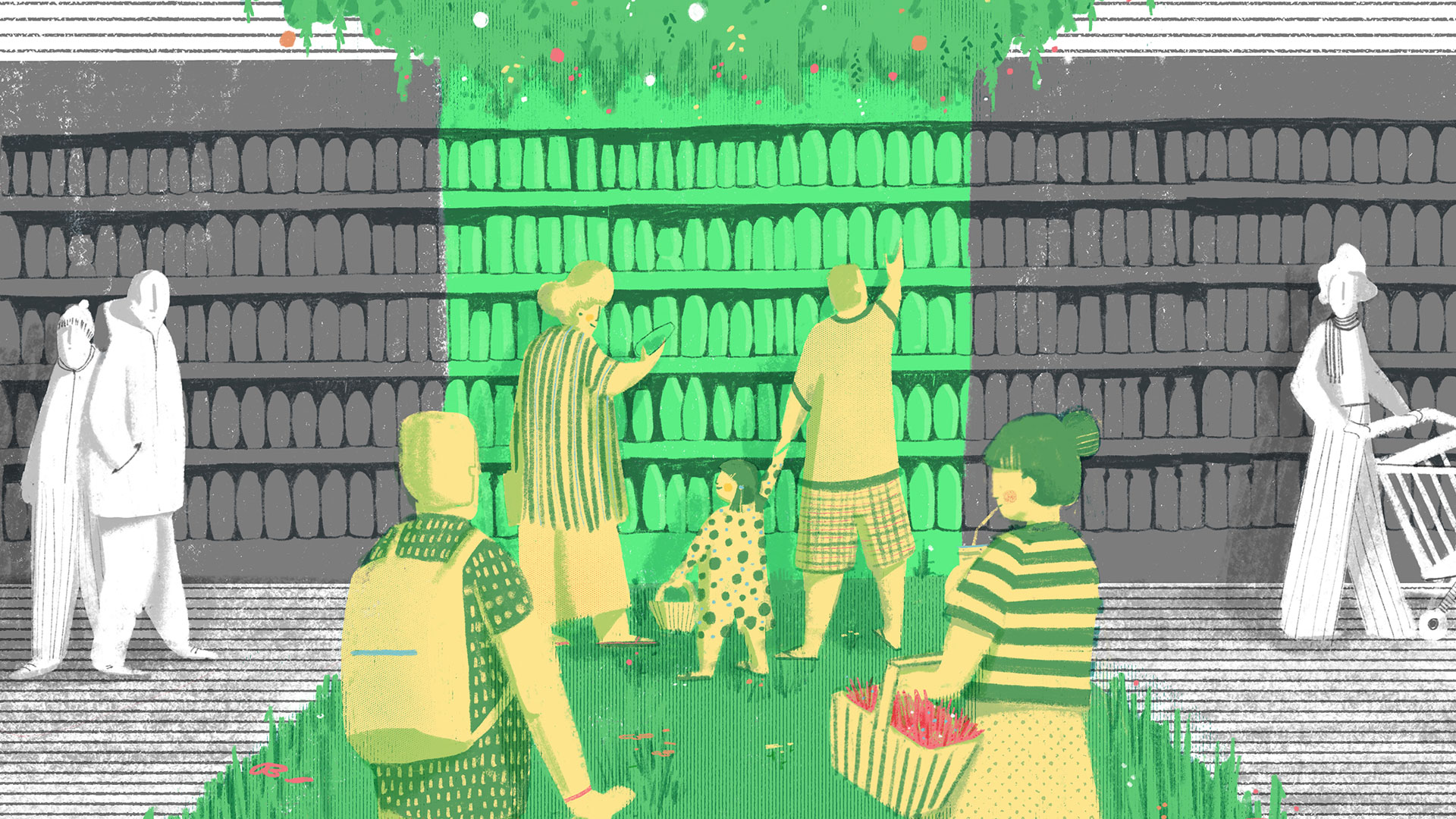

Phoenix Matthews,
PhD, MS, BS, LCP
Professor of Behavioral Sciences at Columbia University School of Nursing
Dr. Phoenix Matthews aims to leverage their academic role to advance social justice and racial equity as a scholar-activist. As Co-director of the HICCC's Community Outreach and Education office, they examine determinants of cancer-related health disparities with a focus on racial/ethnic minorities and other underserved populations.
“I just think about each of us recognizing our privilege and utilizing it for the best possible good in whatever spaces that we occupy,”
says Dr. Matthews, who joined Columbia University School of Nursing as Professor of Behavioral Health Sciences in August 2022.
Previously, they spent time at the University of Illinois Chicago (UIC), an institution with a rich tradition of scholar-activism. There, Dr. Matthews engaged in both research and advocacy around the issue of menthol cigarettes, which are used most frequently by youth and African American smokers. After speaking at a series of town hall meetings, they helped pass Chicago’s first-ever restrictions on menthol-flavored tobacco sales.
At Columbia, Dr. Matthews conducts research in the areas of smoking cessation and lung cancer screening interventions, especially among high-risk populations such as African American men, older LGBTQ+ individuals, and HIV-positive individuals. A key part of that work is developing strategies to increase community awareness and engagement.
“Information alone is not necessarily enough to be able to change hearts, minds, and policy,” they say. “Often times, there's advocacy that needs to accompany that information.”


EXPOSING CANCER'S BURDEN
Understanding and addressing injustice where cancer and the environment meet

Substances we encounter every day—the air we breathe, the water we drink, the products we use, and the food we eat—all contribute to our health and risk for diseases, like cancer. Neighboring communities may have entirely different environmental exposures based on things like access to health services and education, green spaces, healthy food options, and proximity to polluting structures like roads and highways. Communities of color bear the burden of these exposures because of social and environmental inequities, leading to a higher risk of cancer for these groups.
Members of the HICCC are working to uncover more about environmental exposures, how certain groups are disproportionally affected, and identify new interventions for reducing the impact of environmental exposures on cancer risk.
Typically, a patient’s radiation plan is tailor-made by a collaborative team of radiation oncologists, dosimetrists, and medical physicists over the course of about a week. Before radiotherapy begins, the team takes computerized tomography (CT) images of the area of the body that needs treatment and compiles a map (known as the radiation prescription) that indicates which parts need higher doses of radiation than others. In traditional radiotherapy, this map doesn’t change, even weeks into treatment when the tumor may have shrunken or other shifts in anatomy have likely occurred.
Conversely, a small number of commercially-available “adaptive” radiotherapy systems, like Ethos™, allow clinicians to update a patient’s plan on a session-to-session basis, in real-time. So before the patient receives any radiation, Ethos™ double-checks their anatomy with a previously-acquired CT scan. And instead of having the radiation physician draw the outlines of organs and tumors, which normally take several hours to complete, Ethos™ utilizes artificial intelligence (AI) to automatically determine whether the borders of those regions have changed and create a new radiotherapy plan based on these changes.
“This new plan takes only minutes to create, and meanwhile, the patient never gets up off the treatment table,” Dr. Price says. “Then, the physician and the physicist look at this new plan and check the AI’s work. It’s hardcoded into the system that every single computer-generated region and resultant plan must be checked by a human (i.e. physician) before a treatment is delivered.”
In a recent study with Ethos™, Dr. Price and his former colleagues at Vanderbilt University School of Medicine found that the system’s updated plans improved target coverage and decreased the maximum dose to nearby organs-at-risk in patients with cervical and rectal cancers.
Other clinicians at the Herbert Irving Comprehensive Cancer Center (HICCC) look forward to harnessing this technology for their own patients and research studies, with hopes of lowering the toxicity and side effects of treatment.
ANA
NAVAS-ACIEN,
MD, PHD
Professor of Environmental Health Sciences at Columbia University Mailman School of Public Health
Dr. Ana Navas-Acien, who was recently appointed by President Biden as one of six members of the National Cancer Advisory Board, investigates the health effects of environmental exposures such as metals, tobacco smoke, e-cigarettes, and air pollution. She has done extensive research on arsenic exposure through drinking water, finding links to several cancers, including lung cancer, prostate cancer, and pancreatic cancer.
Parts of the U.S. are geologically very rich in arsenic, and these sources then release the chemical into groundwater. At the same time, mining activity contributes to increased arsenic concentrations in the air, water, and soil. Therefore, arsenic in the environment is a result of both manmade and natural activity.
“There are issues of environmental justice that are quite present, which means that not all populations are exposed equally and unfortunately, some communities are more exposed than others.”
says Dr. Navas-Acien.
Her work focuses on contributing evidence of these disparities so that policy changes and interventions can be set in place for these communities to be protected. She directs the Columbia University Northern Plains Superfund Research Program, a center that combines systems science, innovative technology, and traditional knowledge to protect Northern Plains communities and water resources from hazardous exposures.
Ana Navas-Acien, MD, PhD
Professor of Environmental Health Sciences at Columbia University Mailman School of Public Health
PHOENIX MATTHEWS, PHD, MS, BS, LCP
Professor of Behavioral Sciences at Columbia University School of Nursing
Dr. Phoenix Matthews aims to leverage their academic role to advance social justice and racial equity as a scholar-activist. As Co-director of the HICCC's Community Outreach and Education office, they examine determinants of cancer-related health disparities with a focus on racial/ethnic minorities and other underserved populations.
“I just think about each of us recognizing our privilege and utilizing it for the best possible good in whatever spaces that we occupy,”
says Dr. Matthews, who joined Columbia University School of Nursing as Professor of Behavioral Health Sciences in August 2022.
Previously, they spent time at the University of Illinois Chicago (UIC), an institution with a rich tradition of scholar-activism. There, Dr. Matthews engaged in both research and advocacy around the issue of menthol cigarettes, which are used most frequently by youth and African American smokers. After speaking at a series of town hall meetings, they helped pass Chicago’s first-ever restrictions on menthol-flavored tobacco sales.
At Columbia, Dr. Matthews conducts research in the areas of smoking cessation and lung cancer screening interventions, especially among high-risk populations such as African American men, older LGBTQ+ individuals, and HIV-positive individuals. A key part of that work is developing strategies to increase community awareness and engagement.
“Information alone is not necessarily enough to be able to change hearts, minds, and policy,” they say. “Often times, there's advocacy that needs to accompany that information.”
Phoenix Matthews, PhD, MS, BS, LCP
Professor of Behavioral Sciences at Columbia University School of Nursing
CANCER AND THE ENVIRONMENT SYMPOSIUM 2023
In June, clinicians, researchers, and community members gathered for a special “Cancer and the Environment” symposium, where Columbia faculty and other speakers shared updates from their work at the intersection of cancer research and environmental carcinogenesis. Presenters offered an overview of the environment’s impact on cancer risk, highlighting how structural factors and public policy decisions have increased risk and emphasizing the unique responsibility clinicians and community health advocates have for engaging the public on cancer risk reduction.
Substances we encounter every day—the air we breathe, the water we drink, the products we use, and the food we eat—all contribute to our health and risk for diseases, like cancer. Neighboring communities may have entirely different environmental exposures based on things like access to health services and education, green spaces, healthy food options, and proximity to polluting structures like roads and highways. Communities of color bear the burden of these exposures because of social and environmental inequities, leading to a higher risk of cancer for these groups.
Members of the HICCC are working to uncover more about environmental exposures, how certain groups are disproportionally affected, and identify new interventions for reducing the impact of environmental exposures on cancer risk.
Ana Navas-Acien, MD, PhD
Professor of Environmental Health Sciences at Columbia University Mailman School of Public Health
Dr. Ana Navas-Acien, who was recently appointed by President Biden as one of six members of the National Cancer Advisory Board, investigates the health effects of environmental exposures such as metals, tobacco smoke, e-cigarettes, and air pollution. She has done extensive research on arsenic exposure through drinking water, finding links to several cancers, including lung cancer, prostate cancer, and pancreatic cancer.
Parts of the U.S. are geologically very rich in arsenic, and these sources then release the chemical into groundwater. At the same time, mining activity contributes to increased arsenic concentrations in the air, water, and soil. Therefore, arsenic in the environment is a result of both manmade and natural activity.
“There are issues of environmental justice that are quite present, which means that not all populations are exposed equally and unfortunately, some communities are more exposed than others.”
says Dr. Navas-Acien.
Her work focuses on contributing evidence of these disparities so that policy changes and interventions can be set in place for these communities to be protected. She directs the Columbia University Northern Plains Superfund Research Program, a center that combines systems science, innovative technology, and traditional knowledge to protect Northern Plains communities and water resources from hazardous exposures.
Cancer and the Environment Symposium 2023
In June, clinicians, researchers, and community members gathered for a special “Cancer and the Environment” symposium, where Columbia faculty and other speakers shared updates from their work at the intersection of cancer research and environmental carcinogenesis. Presenters offered an overview of the environment’s impact on cancer risk, highlighting how structural factors and public policy decisions have increased risk and emphasizing the unique responsibility clinicians and community health advocates have for engaging the public on cancer risk reduction.
Ana Navas Acien, PhD gave a review of the evidence on metals and arsenic as carcinogens.
More than 200 physicians, researchers, students, and community members attended the forum. They participated in important conversations about the intersection of health justice and environmental science. (Pictured: Nicole Bayne, RN, MPH, COMMUNITY Program Manager)
Columbia researchers such as (from left to right) Phoenix A. Matthews, PhD, Mary Beth Terry, PhD (planning committee chair), and Jasmine McDonald, PhD, shared updates on how the environment impacts cancer risk.
Polly Hoppin Sc.D., presented a systems approach for integrating environmental chemicals in cancer prevention.
A panel of experts discussed moving beyond individual responsibility to systems solutions for cancer risk reduction.
(Pictured, from L to R: Bobbi Wilding, MS; Patricia Bax, RN, MS, NCTTP, ACB; Eileen Z. Fuentes, MA; Sarah Evans, PhD; Micaela Martinez, PhD)
Julia Brody PhD, Executive Director and Senior Scientist at Silent Spring Institute, spearheaded the inaugural Cancer and the Environment forum last year, and was one of this year's conference organizers.

